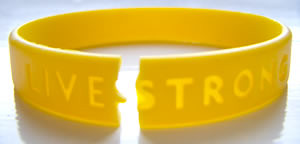Lance Armstrong's LIVESTRONG™
 In the summer of 2004, Lance Armstrong worked his fan-base like no other athlete. He returned to competition, after beating testicular cancer and won another Tour de France. He also launched a charity cancer campaign and published another best selling autobiography. I first came across the LIVESTRONG™ campaign in a Nike town store in San Francisco. At the cash register, the LIVESTRONG™ rubber bands were there in handfuls. They cost only $1 and, at that moment, I thought that this seemed to be an interesting initiative: a charity marketed through the celebrity of someone who had all the characteristics of a hero, accompanied by an attention to style. However, I did not purchase one.
In the summer of 2004, Lance Armstrong worked his fan-base like no other athlete. He returned to competition, after beating testicular cancer and won another Tour de France. He also launched a charity cancer campaign and published another best selling autobiography. I first came across the LIVESTRONG™ campaign in a Nike town store in San Francisco. At the cash register, the LIVESTRONG™ rubber bands were there in handfuls. They cost only $1 and, at that moment, I thought that this seemed to be an interesting initiative: a charity marketed through the celebrity of someone who had all the characteristics of a hero, accompanied by an attention to style. However, I did not purchase one.
Over the course of the summer, LIVESTRONG™ mania caught on around the world. Even a year after they emerged, people can still be seen on the streets wearing them. My next encounter with these rubber bands occurred a month later at the NikeTown store in London, similarly stylish and rubber band aplenty. Accompanying them was a wide range of Lance Armstrong ‘yellow’ clothing. By this point – the end of July – he had won the Tour de France for yet another time. Feeling part of the vibe, I made my purchase proud that I was helping cancer research with my measly £1 (they are a little dearer in the UK, due to the currency conversion). Convincing oneself that cancer research is cool is so much easier when you don’t have to pin a ribbon to your designer jacket, not that I wear such lavish items. But, you see my point; LIVESTRONG™ appeals both on the level of celebrity endorsement and as a sufficiently subtle fashion accessory. Pins are just a little too much of a statement about beliefs, or too much of an inconvenience to wear.
A couple of weeks later, LIVESTRONG™ was most visible from the footage at the Athens 2004 Olympic Games, where a number of athletes wore these rubber bands around their wrists, which surely helped to raise the profile of the campaign. Back in the UK, subsequent weeks would demonstrate the aftermath of LIVESTRONG™. Young children could be seen wearing them, along with a range of similarly coloured counterfeits. The press coverage of LIVESTRONG™ had developed its own momentum. For example, Prince William can be seen wearing the band in a range of photographs about his impending adulthood.
An additional consequence, at least within the UK, has been the emergence of many other kinds of rubber band. We have a blue one that represents a stand against bullying, allegedly prohibited from schools because wearers were bullied! There is also a black and white set of bands – two intertwined – which represents opposition to racism (also a Nike initiative). Most recently, UK Prime Minster Tony Blair has been photographed wearing the ‘Make Poverty History’ blue band. The list goes on, to a point where some schools have banned students from wearing them, because children would have an arm full of rubber bands, which, like jewellery, is seen to be risky to wear in schools
